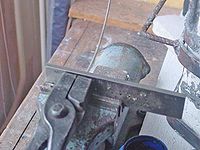
Draw plate
Encyclopedia


Die (manufacturing)
A die is a specialized tool used in manufacturing industries to cut or shape material using a press. Like molds, dies are generally customized to the item they are used to create...
consisting of a hardened steel
Hardened steel
The term hardened steel is often used for a medium or high carbon steel that has been given the heat treatments of quenching followed by tempering. The quenching results in the formation of metastable martensite, the fraction of which is reduced to the desired amount during tempering. This is the...
plate with one or more holes through which wire is drawn
Wire drawing
Wire drawing is a metalworking process used to reduce the cross-section of a wire by pulling the wire through a single, or series of, drawing die. There are many applications for wire drawing, including electrical wiring, cables, tension-loaded structural components, springs, paper clips, spokes...
to make it thinner. A typical plate will have twenty to thirty holes so a wide range of diameters can be drawn.
With a mandrel
Mandrel
A mandrel is one of the following:* an object used to shape machined work.* a tool component that grips or clamps materials to be machined.* a tool component that can be used to grip other moving tool components.- Variants :...
, a draw plate can be used to draw tubes of metal. Plates are available in many different sizes and shapes for drawing different shapes of wire, including round, square, oval, half-round and hexagonal. The plate has rows of holes drilled through it which are slightly wider at the back.
Drawing wire
When drawing, the plate is held securely in a vise or other fixture. AnnealedAnnealing (metallurgy)
Annealing, in metallurgy and materials science, is a heat treatment wherein a material is altered, causing changes in its properties such as strength and hardness. It is a process that produces conditions by heating to above the recrystallization temperature, maintaining a suitable temperature, and...
wire is filed at one end to give it an initial taper. The tapered end is inserted into a hole with a final diameter just smaller than its current width. Special pliers
Pliers
Pliers are a hand tool used to hold objects firmly, for bending, or physical compression. Generally, pliers consist of a pair of metal first-class levers joined at a fulcrum positioned closer to one end of the levers, creating short jaws on one side of the fulcrum, and longer handles on the other...
, called draw tongs
Tongs
Tongs are used for gripping and lifting tools, of which there are many forms adapted to their specific use. Some are merely large pincers or nippers, but the greatest number fall into three classes:...
are used to hold the tip of the wire and pull it through, sometimes with the aid of grease or wax as a lubricant
Lubricant
A lubricant is a substance introduced to reduce friction between moving surfaces. It may also have the function of transporting foreign particles and of distributing heat...
. Small diameter wire may be drawn manually, while very thick wire may require a drawing bench with a crank. Often, a wire can be drawn three times in a row before it needs to be re-annealed. This must be done because drawing wire work-hardens it, which causes the wire to become brittle. Brittle wire that has not been annealed may snap during the drawing process.
Draw plates reduce the thickness of wire by reshaping the metal; increasing length while decreasing diameter. As such, a piece of wire will become considerably lengthened during the drawing process.

